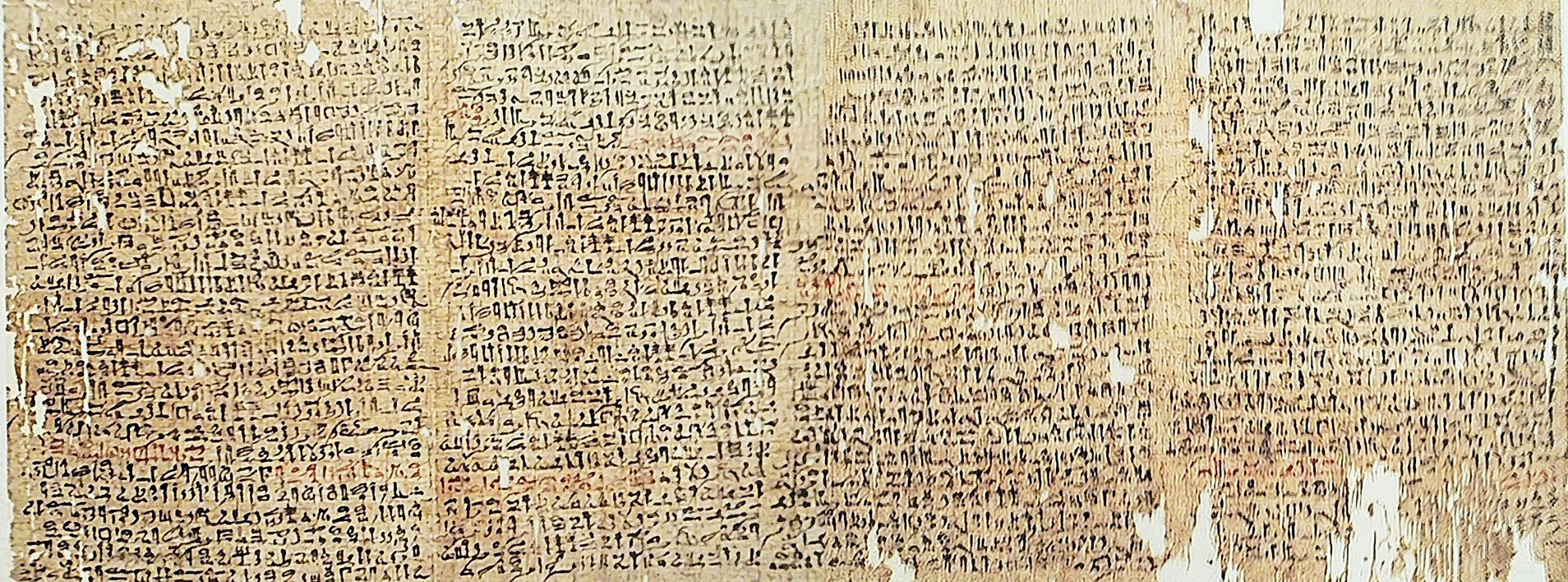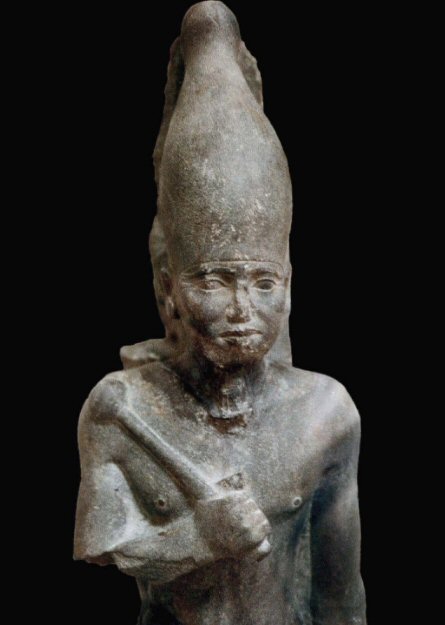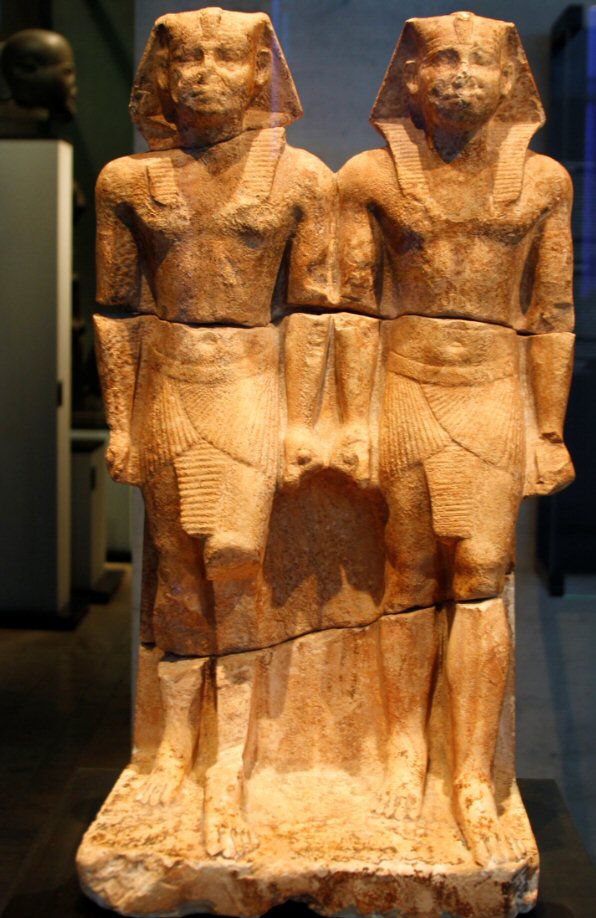 The country as a whole and its administration had not witnessed great changes in the beginning of the reign of Userkaf whose name means (powerful is His Ka). For instance, there are some of the Fourth Dynasty officials who remained in office, such as Nykaankh at Tihna, Middle Egypt.
The country as a whole and its administration had not witnessed great changes in the beginning of the reign of Userkaf whose name means (powerful is His Ka). For instance, there are some of the Fourth Dynasty officials who remained in office, such as Nykaankh at Tihna, Middle Egypt.
It is merely Papyrus Westcar that suggests that Userkaf was the son of Redjedet. On the other hand, there is a tendency to consider him Princess Neferhetepes' son, an extraordinary limestone bust of whom is in the Louvre. But the identity of her husband is not yet fixed. It is suggested that he may have been "Re's priest, Sakhebu's lord" as mentioned in Papyrus Westcar. So we are not sure about Userkaf's origin, but most probably he held an important position in the Re's temple, and he was supported by the priests to have a chance ascending the throne. For this very purpose, he married Khentkawes in order to legitimize his position.
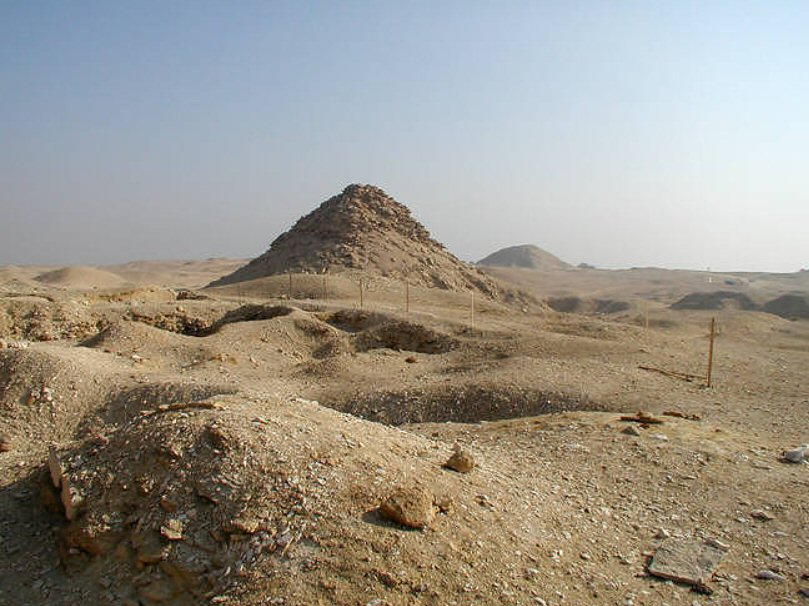
Userkaf's pyramid, located some distance of Djoser's complex in Northern Saqqara is now much ruined.
He also built a sun-temple at Abusir which seems to have been a replica of the one at Heliopolis, thus started a tradition that was later followed by his successors. His choice of Abusir as the location of his sun-temple is doubtlessly connected to the closeness of Sakhebu. Sakhebu was a town thought to have been located at Zat el-Kom, about 10 km north of Abu Roash, almost at a point where the Nile splits off into two branches; namely Damietta and Rosetta.
It was at Abusir where Sahure, Neferirkare, and Neuserre were to be buried.
The new order was also expressed through the Horus name chosen by Userkaf. That name was 'Iry-Maat' which means 'He who puts Maat into practice', Maat being the universal harmony that the creator had to maintain. By this means, Userkaf was deliberately claiming responsibility for the maintenance of creation as a whole. His reign was probably brief. According to the Turin Canon, it lasted over 7 years, which is more plausible than the 28-year-regency span thought by Manetho.
Clearly enough, the early abandonment of his mortuary cult at the end of the Fifth Dynasty indicates his relative importance.
His reign was characterized by certain building achievements, particularly in Upper Egypt, where he enlarged the temple at Tod. This temple was dedicated to Montu, the local god of Theban Region and later also the national god of war. The first known Egypt-Aegean world links can be probably dated to Userkaf's reign, with the evidence of an inscribed stone vessel from his mortuary temple found on Kythera.
The trading links with the Northern Mediterranean throughout the Fifth Dynasty is indicated by the discovery of a chair at Dorak. The chair is stamped with the name of Sahure. And in the surrounding area, various objects bearing the names of Menkauhor and Djedkare-Isesi were found.
The famous monument belonging to King Userkaf is his schist head displayed in the Cairo Museum for the time being. The head was excavated by the Swiss Institute, inside Userkaf's Sun Temple. Unfortunately this temple was destroyed to a great extent.
Papyrus Westcar
 Westcar papyrus contains three different stories. It narrates that one night, Cheops was bored, then asked his advisors what to do. They advised him to call his sons and to allow each of them to narrate a story full of magic. The story reached its peak by its end. Cheops asked his magicians chief to do something widely magical. "Sorry lord, I can not", the chief magician replied. "Then, who can?" Cheops returned. "The only one who can is your eldest son. These children were born by a lady who became pregnant by Re. The eldest son will become a king of Egypt," the magician chief continued.
Westcar papyrus contains three different stories. It narrates that one night, Cheops was bored, then asked his advisors what to do. They advised him to call his sons and to allow each of them to narrate a story full of magic. The story reached its peak by its end. Cheops asked his magicians chief to do something widely magical. "Sorry lord, I can not", the chief magician replied. "Then, who can?" Cheops returned. "The only one who can is your eldest son. These children were born by a lady who became pregnant by Re. The eldest son will become a king of Egypt," the magician chief continued.
At hearing such words, Cheops appeared worried but the magician chief assured that this would happen neither in your time, nor in your sons' time, nor in your grandsons' time. Thus, it will be Userkaf. Then, the story goes on relating the pregnancy of the lady, who was a priest wife, then the goddesses' help to that pregnancy. This text was preserved in the Middle Kingdom, but the occurrence of its events was during King Cheops period. So, probably the version in the Middle Kingdom was a copy of an earlier text written during the Fifth Dynasty as a sort of political propaganda for the Fifth Dynasty.
Sahure
 Sahure was the second king of the Fifth Dynasty, the successor of Userkaf. He ruled for 14 years.
Sahure was the second king of the Fifth Dynasty, the successor of Userkaf. He ruled for 14 years.
Sahure is the first king of the Fifth Dynasty to has his pyramid built at Abusir. The reliefs, in the mortuary temple include the usual representations of captives of the conquered countries. But they also show the return of trading expeditions from Byblos, as well as expeditions to Syria. A campaign against Libyans was also sent during Sahure Reign, although there is some doubt about this issue.
He sent expeditions to exploit the mines in Sinai, and to quarry diorite in the west of Aswan, and to Punt which is mentioned on the Palermo Stone and perhaps also depicted on the reliefs in Sahure's mortuary temple.
There is evidence for trade links with Punt throughout the Fifth and Sixth Dynasties, and especially during the Middle Kingdom: the reign of Mentuhotep III, Senusert I and Amenemhat II left valuable indications of the route followed by the traders. These links with Punt were continued throughout the New Kingdom, in the reigns of Thutmosis III, Amenhotep III, Horemheb, Seti I, Ramses II, and especially Ramses III. But trade died out, and by the end of the Pharaonic Period, journeys to Punt had become mythical events.
He built his sun-temple at Abusir in which he used the most expensive materials, and was greatly interested in decorating its halls, courts, granite pillars and columns with palm capitals. A pipe-line system was discovered under the floor of this solar temple which was considered to be the first sewage system. These pipes were made of copper and linked together with lead.
Neferirkare
 He was Sahure's brother according to Papyrus Westcar, and the Palermo Stone was probably carved during his reign. His reign extended over 12 years.
He was Sahure's brother according to Papyrus Westcar, and the Palermo Stone was probably carved during his reign. His reign extended over 12 years.
He built his pyramid at Abusir. He did not follow the same policy of his predecessor Sahure, which was related to military activities. Yet, he was known for his religious tendency and his care for the priests and temples.
There is some evidence recording that he used to present gifts and offerings to different temples, in addition to his interests to please and satisfy priests. Consequently, the authority and wealth of the priests swelled. He even issued a decree to exempt them from taking part in the country projects. The priests' tombs in his reign give sufficient evidence to how greatly they were appreciated by the King. His famous vizier 'Washyptah' was mummified and buried in a special way, following the King's instructions.
Very important papyri's archives from Isesi Reign to Pepi II Reign were preserved in Neferirkare's mortuary temple at Abusir, a temple excavated between 1893 and 1907. This was the most important papyri collection from the Old Kingdom until the 1982 expedition of the Egyptological Institute of Prague University discovered an even richer cache in a storeroom of the nearby mortuary at Neferefre temple.
Neferefre
 Neferefre's mortuary temple was excavated by the Prague Expedition. To some extent, the discoveries made between 1980 and 1986 have modified the general perception of this King, who had previously been regarded as second-rate on the grounds that his pyramid was unfinished. Neferefre's reign is a great creative period. We deduced such a piece of information at excavating a cache of papyri documents, inscribed plaques, wooden boats, prisoners' statues and sculptures of the King himself in 1985. His statue depicts him sitting on a throne, with Horus protecting him from behind.
Neferefre's mortuary temple was excavated by the Prague Expedition. To some extent, the discoveries made between 1980 and 1986 have modified the general perception of this King, who had previously been regarded as second-rate on the grounds that his pyramid was unfinished. Neferefre's reign is a great creative period. We deduced such a piece of information at excavating a cache of papyri documents, inscribed plaques, wooden boats, prisoners' statues and sculptures of the King himself in 1985. His statue depicts him sitting on a throne, with Horus protecting him from behind.
Neuserre
Neuserre reigned for about 32 years and he might be Neferirkare's son. Neuserre built his pyramid at Abusir. He constructed his valley temple using fragments taken from Neferirkare's unfinished constructions located also at Abusir. He built a sun-temple at Abu-Ghurab that has survived intact. It is the only extant structure built entirely of stone. Because of this sun-temple, Neuserre Reign is considered the peak of the Solar Cult.
On the walls of Neuserre's sun-temple, many scenes show his Sed-Festival, in addition to some scenes of his wars in Syria and against the Libyans. However, there is some doubt whether he had led these wars, or rather the scenes were basically a copy of those in the temple of Sahure nearby.
During his reign, the provincial governors and court officials gained greater power and independence, creating a movement that threatened the central authority. Their wealth is clear from the Fifth Dynasty Mastaba of Ti at Saqqara. Ti was an official, who married Princess Neferhetepes, pursuing his career during the reign of Neferirkarre, and died during Neuserre period. The size of the tomb he built for himself and his family, and the quality of its decoration would have been beyond the means of a private individual in the previous dynasty.
Menkauhor
 The pyramid of Menkauhor has not yet been identified, and it is difficult to decide whether it is more likely to have been at Dahshur or at Northern Saqqara, where a personal cult was dedicated to him in the New Kingdom.
The pyramid of Menkauhor has not yet been identified, and it is difficult to decide whether it is more likely to have been at Dahshur or at Northern Saqqara, where a personal cult was dedicated to him in the New Kingdom.
It has been suggested that he was the owner of the ruined pyramid to the east of Teti's at Northern Saqqara, but this was proved wrong by the existence of the remains of a Third Dynasty mastaba in its southern corner.
The location of his sun-temple is not definitely known. It may be located at Abusir, but if so, he would have been the last to use the site, since his successors moved the royal necropolis back to Saqqara.
Isesi (Djedkare)
 He did not move away from the Heliopolitan Cult, as he chose the name Djedkare that means "the Ka of Re is Stable" as his Nsw-bity title, thus placing himself under the protection of the god Re, but, he did not build a sun-temple.
He did not move away from the Heliopolitan Cult, as he chose the name Djedkare that means "the Ka of Re is Stable" as his Nsw-bity title, thus placing himself under the protection of the god Re, but, he did not build a sun-temple.
He was buried in a pyramid at Southern Saqqara.
Manetho suggests that his reign lasted for about 40 years, but this figure is not confirmed by the Turin Canon, which refers to a reign of only 28 years, indicating that he had celebrated his Sed-Festival, the evidence for which is an inscribed vase in the collection of Louvre Museum.
He was very active in his political and trade relations with Egypt's bordering neigbours. In Sinai, two expeditions at l0-year intervals are recorded at Wadi Maghara. He also sent expeditins to the diorite quarries at the west of Abu Simbel, to Byblos and the land of Punt. His expedition to Punt is recorded in a graffito found at a Lower Nubian site. It was evidently still remembered in the time of Merenre of the Sixth Dynasty.
During his reign, officials continued to gain more power, and the viziers who took office during his period had their especially-built tombs at Saqqara. Reshepses, the first governor of Upper Egypt, is one of these officials.
The most famous noble living in Isesi Reign was Ptahhotep, who was the instructor of the King's son who left a group of valuable and interesting teachings. His grandson Ptahhotep Tshefi, who lived in the Wenis Reign, was buried nearby in an annex of the mastaba of Akhethotep, a son of the first Ptahhotep and also a vizier. It is to the second younger Ptahhotep that the Maxims are usually ascribed. These texts have survived in the form of about ten different manuscripts, four of which (namely a papyrus and three ostraca) found in the Workmen's Village at Deir el-Medineh. The attribution of the Maxims to Ptahhotep does not necessarily mean that he was their actual author: the oldest versions date to the Middle Kingdom, and there is no proof that they were originally composed in the Old Kingdom, or more specifically at the end of the Fifth Dynasty. The contents of these Maxims define general rules for life.
The political and administrative personnel of the late Fifth Dynasty displayed a remarkable continuity in contrast with the Royal Family.
We know from the biography of the ruler of Aswan, Harkhuf, who led many expeditions towards the south in the time of some kings of the Sixth Dynasty that one officer brought a dwarf to the king in Isesi Reign.
Wenis
He is thought without any real proof to have been the son of Isesi. Manetho claims that Wenis was the last ruler of the Fifth Dynasty.
His reign is generally thought to have been the end of the classic phase of the Old Kingdom, whereas the Sixth Dynasty represents the beginning of a period of decline that stretches on into the First Intermediate Period until the reunification of the Two Lands by Nebhepetre Mentuhotep II.
His reign is estimated to be extending over about 30 years by both Manetho and the Turin Canon.
Egypt pursued a policy of diplomatic contact with Byblos and Nubia. Also active building projects took place in Elephantine and Northern Saqqara, where the Wenis funerary complex displays a grandeur that elevate him later to the level of a local god.
On the interior walls of his pyramid at Saqqara, we find the Pyramid Texts inscribed for the first time. Besides, his causeway was decorated with scenes depicting the King performing some rituals, and other scenes depicting agriculture and hunting.
The Pyramid Texts

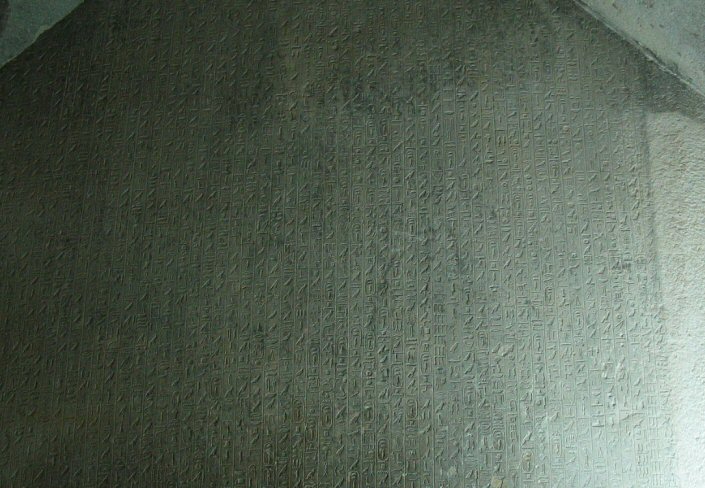
The Pyramid Texts are some hymns and prayers, the main aim of which is to help the deceased to pass through and overcome the difficulties that he would face in the afterlife. The use of these texts continued till the 6th Dynasty, where they were found written inside the pyramids of Teti, Pepi I, Merenre and Pepi II, as well as in the pyramids of some queens of this dynasty in southern Saqqara.
